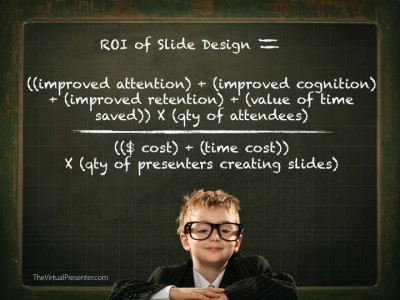Leaning toward an ROI of slide design
Consider this analogy: Great storytelling is about more than the story. When it’s shared live, a great storyteller can dramatically improve how much you enjoy it, learn from it, remember it. When it’s written to be read, the writer’s skill can similarly make or break the experience for you.
So what about the slides you use in a webinar, webcast, or virtual classroom?
We know that the audience’s sensory inputs change in relative importance. For instance, two of my studies have shown that voice is more important online than off, and one of them suggests that great slides can significantly help your cause, too.
Lightly simplified, return on investment is dividing your costs into your benefits, right?
So if we were going to study the value of great slide design, we’d have to isolate, measure, and monetize the impact points. We’d start by looking at potential costs and benefits, maybe with a brainstorm like this:
On the benefit side:
- We learn and remember best through pictures (John Medina, Brain Rules)
- We don’t pay attention to boring things (John Medina, Brain Rules)
- We want to look at (and even share) great pictures (Pinterest!)
- Text (and charts and tables and…) can be formatted to improve understanding and memory (Stephen Kosslyn, Clear and to the Point: 8 Psychological Principles for Compelling PowerPoint Presentations)
- Some things may be better explained with visuals, decreasing time-to-understanding (saving time)
- Benefits in attention, cognition, and retention would be multiplied times the number of participants in the presentation or class (in other words, more time spent by one or a few people has an impact on a bunch of people)
- Your organization or department may have other brand benefits when you do something compelling and refreshing relative to your competition
On the cost side:
- Design takes time learn and do
- Imagery may cost you money, sometimes good money (in the 6+ years here at 1080 Group, we’ve spent $6500 on licensing images)
- Imagery may cost you time (“free” such as Flickr can take much longer to find and edit to communicate the right message)
- Politics. Face it, one of the most common complaints is that the boss doesn’t understand (or care about) the difference between visually compelling and same-boring-ass-thing-that-everyone-else-does-that-we-complain-about, and there’s a cost to fighting for what’s right
- Lost attention, cognition, retention, and all that other stuff above
Worth noting:
- You do not have to be a “designer” to learn how to improve the impact of the stuff you put on slides
- Your design skills and speed improve over time
- Over time you also build a library of slides, designs, images, parts and pieces that save you time and money
- To be fair, while most of us like well-designed stuff, sometimes what you need to accomplish does not warrant a higher investment
The bottom line
One bit of irony is that there are organizations who culturally reward (or punish) people who don’t dress for success. Or who otherwise make sure their print ads or tradeshow booths or corporate lobby look great. Or who otherwise pay particular attention to what is being communicated explicitly and implicitly in various ways, but then they let their teams flounder with slide design skills and resources.
The question on the table…isn’t it at least worth a conversation about whether or not your design priorities are upside down?

Linda Cahan
This is all excellent information Roger -thanks so much for sharing it!